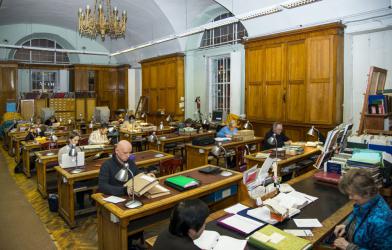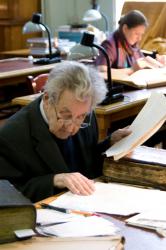First Half of the 20th Century: Manuscript Books and Archival Documents
The first significant acquisition of the twentieth century was the huge collection of the Rostov industrialist and ethnographer Andrey Titov. The collection of the Rostov merchants' dynasty numbers 4,676 Russian manuscripts ranging from the 13th to 20th centuries. The manuscripts entered the library in 1902, 1909, 1913, 1915, 1947, 1950, 1954. A six-issue catalogue compiled by Titov and a detailed six-volume description of manuscripts were released simultaneously. The collector did not have time to complete this work.
Of particular importance are three interesting collections acquired in the early twentieth century. The literary critic Nikolay Dobrolyubov's archive was recieved in 1906. In 1913, Nicholas II donated to the Library a small collection given by the Emir Alim Khan of Bukhara as gift for the 300th anniversary of the Imperial House of Romanov. It also should be mentioned 113 Greek manuscripts, bought from the Greek scholar Athanasios Papadopoulos-Kerameus, the head of the theological section of the Library.The Great Russian Revolution of 1917 and subsequent historical changes led to the great growth of the department’s collections. One such change included a broad policy for the acquisition of national handwritten landmarks. The department incorporated items from numerous sources: many private libraries were nationalized, state institutions were abolished. Collections from them were transferred to our library. Thus, the Library received the collections from the palaces in St.Petersburg Imperial Suburbs Pavlovsk and Peterhof. At the same time, because of a redistribution of the State Archival stocks, the Library lost many rarities, including the autographs of the gteat Russian authors Alexander Pushkin, Leo Tolstoy and Maxim Gorky, as well as related materials.
The Manuscripts Department incorporated large manuscript collections from monastary libraries and church institutions. In 1919, the collection of St. Sophia's Cathedral was moved from Veliky Novgorod. It consists of 1,585 Old Russian manuscripts produced on the vast territory of the Russian north, from the Baltic Sea to the Ural Mountains, as well as books from the libraries of many other Novgorod monasteries. At the same time, the Kirillo-Belozersky Monastery collection came in the Library. It is one of the ealiest monastic libraries founded at the beginning of the 15th century by Saint Cyril. Most of the books were transferred from the monastery to the St. Petersburg Theological Academy in 1859, and subsequently, they entered the Public Library as part of the Academy's collection, containing 1,485 manuscripts ranging between the 10th and 20th centuries in Old Russian, Greek, Latin, German, French, Hebrew, Syriac, Ethiopian and other languages.
In 1928, the famous Solovetsky Monastery Library (1482 manuscript books of the 13th – 19th centuries) was shifted from the Kazan Theological Academy where it had been housed from the mid-19th century. In the same year, the department was replenished with the library of the Novgorod Theological Seminary, containing 261 manuscripts of the 16th – 20th centuries in Old Russian, Greek, Western European and Eastern languages. It includes manuscripts that once belonged to the famous church reformer of the Peter the Great's era Theophan Prokopovich.
In 1929, the Library received 110 manuscript books ranging between the 15th and 19th centuries and archival materials of the late 18th and 19th centuries from the Alexander Nevsky Monastery. In 1940, the collection of the Volkovo Prayer House of Old Believers' tradition in St. Petersburg, consisting of 122 manuscript books of the 16th – 20th centuries, was received.In 1932, the collection of the Society of Lovers of Ancient Literature added to the Old Russian stocks more than 3,000 Russian and Slavonic manuscripts, among them the celebrated Kievan Psalter of 1397. At the same time, the library acquired the valuable manuscript collection of the society's founder, Pavel Viazemsky.
The stocks of the manuscript books and archival materials grew very fast. In 1919, the government allocated funds to purchase a collection of autographs amassed by P. Waxel and E. Yurgenson. It includes more than 9,000 documents, of which more than 6,000 are autographs of Russian state and military leaders, writers, scientists, artists, composers, musicians, singers and drama artists. In the post-revolutionary years, the manuscripts of the medieval historian Ivan Greaves, the bibliographer and researcher of the war of 1812 Konstantin Voensky, the historian and statesman Pavel Milyukov, the literary critic D.V. Filosofova came in the library.
Since the twentieth century, the flow of Eastern manuscripts into the Library has significantly decreased, because the centre for Oriental studies shifted to the Asian Museum (now the Institute of Oriental Manuscripts in St. Petersburg). However, the Eastern stocks continued to grow due to acquisition of individual manuscripts and small collections. For instance, in 1919, an employee of the Library, Yu. Danzas, presented 42 Muslim manuscripts belonging to her father. In 1939, 75 Arabic manuscripts were purchased from A. Tamay, an inhabitant of Makhachkala.
In the 1920s, after the nationalization of book collections, Western holdings were enriched with two dozen later mediaeval Books of Hours from the royal palaces at St. Petersurg's suburbs Pavlovsk and Peterhof, as well as from the city residence of the House of Yusupov. Some of these prayer books are distinguished by extremely high artistic merit. Among them are the so-called the Luxembourg Book of Hours and the Books of Hours of the Rolin-Lévy Family, as well as an prayer book illustrated in the style of the prominent French medieval painter Jacquemart de Hesdin. During this period, single manuscripts in European languages were transferred from the libraries of noble families (Stroganovs, Sheremetevs), the State Book Collection, etc.
An important acquisition was the foreign part of the Waxel – Jurgenson autograph collection. It contains about 3 thousand documents, mainly letters, which trace the history and culture of European countries. Among the most interesting documents is a handwritten letter from Mary Stuart, Queen of Scots, written two months before her execution and addressed to her cousin Henry I, Duke of Guise.
The first half of the century saw not so much acquisitions, but rather losses. Over 13,000 manuscripts from the Zaluski Library and other Polish libraries have been returned to Poland. By the decision of the government, a number of excellent illusrated manuscripts was confiscated for sale through the State Import and Export Trading Office. The confiscated items included not only new acquisitions, but also some of the Dubrovsky manuscripts from one of the foundation collections of the Public Library. Currently, some of the Dubrovsky manuscripts are stored in the National Library of France, the Royal Library in the Hague, and the P. Getty Museum in the USA.
During the Second World War, all manuscript collections, as well as the most valuable printed publications, were evacuated in the city of Melekes (Volga region). Their return was followed by careful work to arrange and place the handwritten materials. Gradually, the acquisition was resumed.

